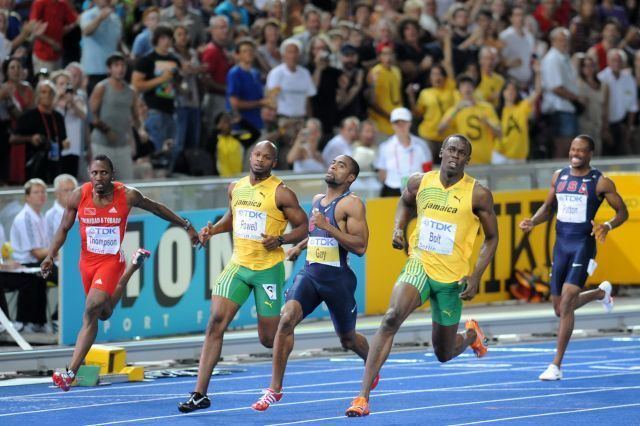 | ||
World records in athletics are ratified by the International Association of Athletics Federations. Athletics records comprise the best performances in the sports of track and field, road running and racewalking.
Contents
- Criteria
- Bonus payments
- World records
- Key to tables
- Best performances in non IAAF World Record events
- References
Records are kept for all events contested at the Olympic Games and some others. Unofficial records for some other events are kept by track and field statisticians. The only non-metric track distance for which official records are kept is the mile run.
Criteria
The criteria which must be satisfied for ratification also apply to national or other restricted records and also to performances submitted as qualifying marks for eligibility to compete in major events such as the Olympic Games.
The criteria include:
Bonus payments
Witnessing a world record brings great pleasure for athletics fans; athletes' personal sponsors and the promoters of major meetings such as the IAAF Diamond League and its predecessor, the IAAF Golden League have offered bonuses to athletes breaking a record.
Some middle-distance runners have specialized in acting as pacemakers in longer races, receiving a fee without even finishing the race, and possibly a bonus if a record results. This is a useful occupation for athletes who are capable of running accurately to a specified pace, but not capable of the very fastest times to become champions in their own right.
In the pole vault record bonuses create an incentive for an athlete capable of smashing a record to instead break it by the minimum amount (one centimetre), multiple times, at multiple meetings, in order to accumulate multiple bonuses. This has been done by Sergey Bubka in the men's pole vault, and Yelena Isinbayeva in the women's pole vault. Some commentators have complained that neither athlete ever posted as high a mark as they were capable of. In other disciplines this issue does not arise, since it is practically impossible to deliberately break a record by a small margin, except in the high jump.
World records
The IAAF started to recognize world records in 1912, and indoor world records after 1987. In 2000, IAAF rule 260.18a (formerly 260.6a) was amended, so that "world records" (as opposed to "indoor world records") can be set in a facility "with or without roof." This rule was not applied retroactively, and has thus far only affected the men's and women's pole vault. The women's record has been advanced 9 times indoors by three different women, each ratified as a world record. The last record to be set indoors was in 2004. Sergey Bubka's 1993 pole vault world indoor record of 6.15 m was not considered to be a world record, because it was set before the new rule came into effect. In February 2014, Bubka's record was surpassed indoors by Renaud Lavillenie jumping 6.16 m which qualifies as both the Indoor world record and the world record.
Key to tables
Awaiting ratification
ht = hand timing
+ = en route to a longer distance
A = affected by altitude
OT = oversized track
X = annulled due to doping violations
# = not officially ratified by IAAF
a = aided road course according to IAAF rule 260.28
est = estimate
i = set indoors (overall world record tables only)
Best performances in non-IAAF World Record events
Events which do not qualify for IAAF-ratified world records are typically referred to as world bests. While very common in the first half of 20th century, a large number of races over distances by imperial measurements became rare occurrences and the IAAF removed all imperial measured events from its world record lists in 1976 – with the sole exception being the mile run (which remains common due to its historical prominence in track and field).
Some road racing distances and indoor variations of outdoor events fall outside of IAAF's lists. Records set in uncommon events usually do not adhere to the strict criteria found in IAAF-ratifiable events. One example is the 150 metres record, which was set by Usain Bolt on a specially-made straight track, while previous performances (such as the Bailey–Johnson 150-metre race) were completed on a traditional circuit which included a partial bend in the track.
The 40 yard dash – a standard acceleration evaluation for American Football players – does not fall within the usual criteria of athletics racing events. In most 40 yard dashes, reaction times are not recorded as timing starts only once the player is in motion, and the standards for timing a "football 40" are so lax and inconsistent that a real world record cannot be claimed. Performances are hand-timed and calculated to 1/100th of a second, although studies show human beings simply cannot react consistently or accurately enough for this to be a valid method; even those using light beams are timed by the motion of the athlete, still removing the normal factor of reaction time. All these factors make track and "football 40" performances incomparable. The world best time for a "football 40" is 4.17 by Deion Sanders. The extrapolated best for an Olympic level athlete, including reacting to a starting gun, currently is by Maurice Greene at the 2001 World Championships in Athletics with a time of 4.24.
